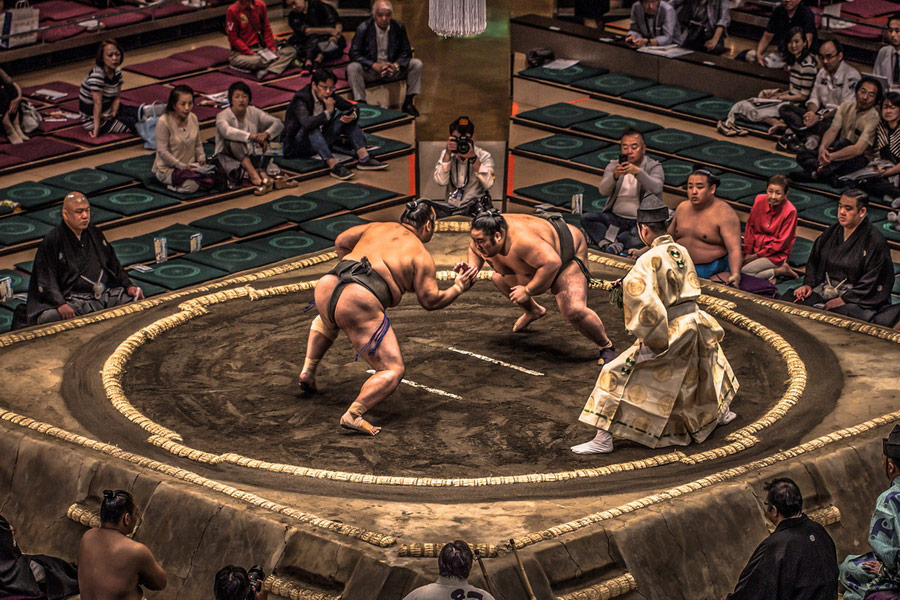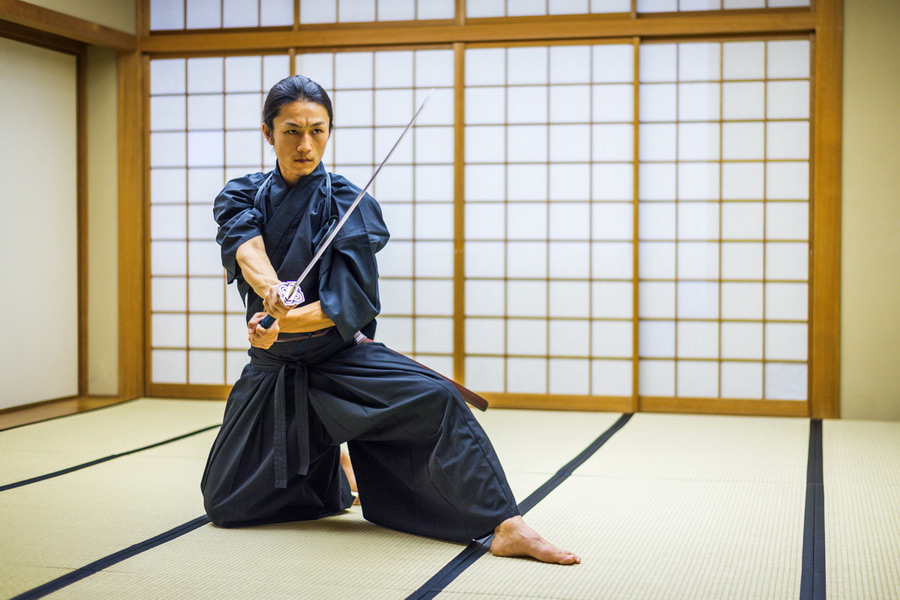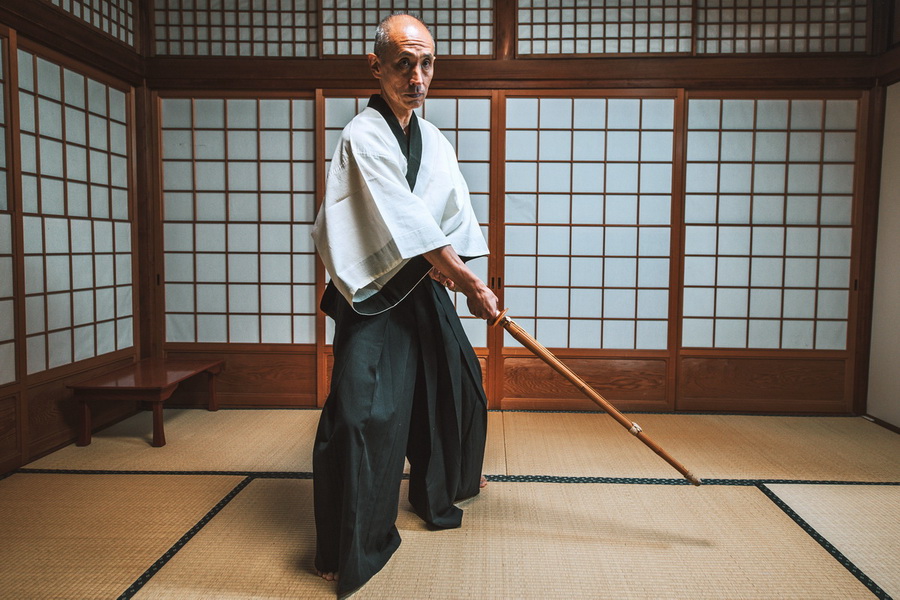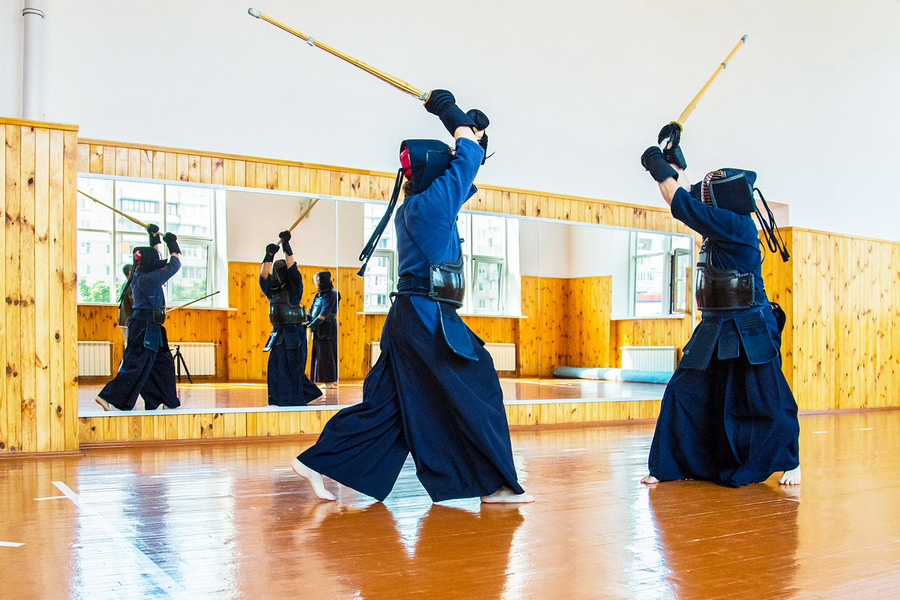Japanese Martial Arts

Japanese martial arts, including judo, sumo, and karate, are among Japan’s most renowned and successful cultural exports. The black belt, which appeared in judo during the early 20th century, is an iconic image globally. Despite their enduring popularity, many people have limited knowledge about Japanese martial arts.
Before you travel to Japan, join us as we explore the history and culture of these ancient forms of self-defense. You will also learn about the related events, activities, and attractions. Furthermore, why not visit Japan, for example, during sumo tournaments or judo sessions? Or, let's say, experience traditional kyudo in Nara?
What are Japanese Martial Arts?
The Japanese martial arts represent various styles that developed over centuries of Japanese history. Many of them ingrain the code of behavior and the state of mind and spirit associated with the imported Buddhism religion, particularly Zen and Mahayana. These practices are a vital part of Japanese culture, reflecting its rich heritage and philosophical depth.
In Japanese, the terms 武道 (budo), 武術 (bujutsu), and 武芸 (bugei) are related but distinct in referring to aspects of martial arts. The word budo (martial way) has a modern connotation, while bujutsu and bugei historically have a different meaning. The former means combat techniques on an actual battlefield; the latter, connected to the formal learning setting, implies adjusting military skills and tactics for educational purposes.
It’s important to know that budo, bujutsu, and bugei are generally not used to refer to Western or American sports, stressing Japanese identity versus even modern mixes containing foreign notions of sports.
The suffix “do” in Japanese, translating as “way” or “path”, transcends mere technical training to encompass a broader philosophical realm. In martial arts like Kendo and Aikido, this concept emphasizes the spiritual and moral dimensions of practice, aiming not just at physical proficiency but also at personal growth and enlightenment. Practitioners are encouraged to pursue “do” as a way of life, fostering virtues such as respect, integrity, and perseverance. This holistic approach helps individuals achieve not only mastery over the techniques but also maturity and deeper self-awareness, aligning their martial arts practice with their spiritual and ethical development.
Origin and History

The martial arts have a long history in Japan. While the country has indigenous fighting disciplines, some are influenced by Chinese combat styles. However, Japan systemized and popularized them. According to Asakawa Kanichi, the roots of bujutsu can be traced back to the mid-and late Heian period (between the tenth and twelfth centuries) when the samurai cast emerged.
The adopted Chinese-style institution after 645 AD led to the order system known as the Ritsuryo codes of the Nara period. However, in the early Heian period, the system of social order that concerned tax, land, and local administration loosened. Land stealing, warfare, and regional rebellion became a frequent scene.
Since the central government was weak and couldn’t control the situation, provincial families (usually strong farmers) armed themselves to defend their belongings. Once the self-defense bands were organized, the aristocrats started to seek protection from bushi (warriors) skilled in battles with weapons. Later, the high-ranking bushi who served the imperial court or nobility were named samurai (originally saburai).
The Edo Period (1603-1868)
With the end of the Sengoku era (Warring States Period) and the beginning of the peaceful Edo period, the role of the samurai became formalized. Although there was no more need for armor, fighting techniques were encouraged as part of the samurai's education, shifting from combating external enemies to controlling internal foes, like personal weaknesses.
The Tokugawa shogunate implemented the "Sword Hunt" (katanagari) policies to disarm the population and solidify social order, prohibiting the possession of swords and firearms among the peasantry. These policies not only limited the physical means to oppose the shogunate but also controlled the spread and practice of martial arts, ensuring that warrior skills were confined to the samurai class to prevent potential uprisings.
Additionally, the government's concerns over public order led to restrictions on martial arts schools (dojos), with swordsmanship gaining prominence despite not being a primary weapon. These regulatory measures played a crucial role in shaping the martial culture of the period, maintaining a strict hierarchy and social stability under Tokugawa rule.
The Meiji Period (1868-1912) and Onward

The arrival of foreigners and domestic challenges in the 19th century spurred attempts to remilitarize the samurai and rejuvenate interest in martial arts. The Meiji Revolution brought Westernization and changes to the samurai class, leading to a crisis of identity and negative views of samurai.
Following Japan’s victory over China in the Sino-Japanese War (1894-1895), bushido took on a more nationalistic tone. The victory led to many new dojos and clubs, and bushido was seen as the best way to show Japanese nationalism. Martial artists became fervent promoters of bushido, symbolized by the samurai.
During the imperial period, kendo and judo became widespread across Japan. Kendo, in particular, was closely linked to nationalistic and imperial bushido ideologies. A symbolic link to Shinto symbolism and idealized samurai warriors, the sword connected kendo to nativist militarism more profoundly than most other forms.
The 20th Century
Since 1924, the Meiji Shrine in Tokyo has hosted an annual sports competition to celebrate the Meiji Emperor's birthday, prominently featuring kendo. The event sought to instill imperial loyalty in the participants, and the Meiji Shrine still maintains an active martial arts hall today.
As elementary education became widespread in Japan, spiritual elements, including budo, increasingly penetrated secondary school curricula. In 1919, bujutsu was changed to budo to reflect this shift.
Martial arts helped Japan build relationships with other countries and make its culture known worldwide.
Judo was slated to be included in the 1940 Olympics, marking a significant event; however, the games were canceled due to World War II.
Western perceptions of bushido significantly influenced the development of martial arts in Japan. This cross-cultural exchange led to the modernization and global spread of Japanese martial arts, helping them evolve beyond their ancient forms into globally recognized sports and cultural symbols.
After Japan lost the war in 1945, practices related to militarism, including samurai films and martial arts, were banned. However, as the US shifted from demilitarizing Japan to rebuilding it as an ally, the martial disciplines were revived, with limitations. Their continuity with the imperial period persisted despite a break from the past. The 1964 Olympics helped symbolize Japan's postwar rehabilitation.
Exploring Japanese Martial Arts: Styles and Classifications

Today, there are about two dozen Japanese martial arts. At least two classification schemes can help categorize them.
Armed Versus Unarmed
One easy way of classifying Japanese martial arts is by splitting them into armed and unarmed.
Armed styles involve the use of weapons in disciplines such as kenjutsu and kendo (sword), kyudo (archery), and bojutsu (staff).
Unarmed arts, like judo, sumo, jujutsu, karate, and aikido, don't use any weapons. These combat types involve kicking, grappling, striking, and ground wrestling.
However, no matter the fighting style, disciplining human character is paramount. Whether it's mastering the katana in kendo or embracing Jita Kyoei (mutual aid) in judo, these disciplines aim to mold both body and mind, fostering better individuals.
Koryu Versus Gendai Budo
The most common way to break down Japanese martial arts styles is by historical period, which carries technical and philosophical distinctions. Koryu, translated as "old school", describes schools established before the Meiji Restoration in 1868. These schools have a direct lineage to ancient samurai practices and focus significantly on combat effectiveness and traditional techniques. In contrast, gendai budo, or "modern martial ways", generally refers to styles systematized after the Meiji Restoration, often emphasizing personal development and sport rather than combat readiness. For example, kyudo practitioners uphold a strong philosophical belief in shin-zen-bi (truth-goodness-beauty), asserting that when archers shoot with truth and good spirit, the result will not only be technically proficient but also aesthetically beautiful.
The modern concept of sports as a match, where winning is a prime concern, was not customary among koryu fighters. Historically, these practitioners trained for practical combat readiness and personal betterment, not merely to win matches. Gendai budo disciplines, on the other hand, promote teamwork and socially healthy values that do not require dangerous techniques as in ancient times, adapting martial arts to contemporary societal needs.
Six Influential Japanese Martial Arts Styles
Despite various Japanese martial arts, some are more popular than others. Check out the list below to explore the six most common and influential styles.
1. Sumo

Sumo (相撲) is one of the most well-known. Considered a national sport, this form of wrestling developed as a ritual dance to entertain Shinto deities at religious celebrations. Over time, the fighting techniques became part of military training.
The sumo contest is distinguished by quick slapping, tripping, and pushing of an opponent out of the sumo ring, called a dohyo, aiming to make him touch the ground with any part of the body except for the soles of the feet. Each round usually lasts a few seconds. That’s why the weight of the wrestler is so important. Unusual traditions, judges adorned in colorful garments, and the salt-throwing ritual (shiomaki) make this sport truly unique.
Sumo has a rich history spanning almost 1,300 years, beginning in 728 AD when Emperor Shomu initiated official sumo tournaments at the annual harvest festivals.
Today, the International Sumo Federation (IFS) encompasses over 87 member countries. The Japan Sumo Association holds six grand competitions (Honbasho) annually, each lasting 15 days. Tokyo’s Kokugikan hosts tournaments in January, March, and September, while Edion Arena in Osaka (March), Nagoya (July), and Fukuoka (November) each host one tournament.
Although the International Olympic Committee recognizes sumo for its cultural significance, it has not yet been included as an official event in the Olympic Games.
While visiting Japan, sporting fans can leverage the opportunity to watch sumo live. You can get your hands on tickets from BuySumoTickets or the official sumo website – Ticket Oosumo, or purchase tickets near your convenience store.
If you are interested in sumo-related activities, be sure to add these to your travel list:
- Visit one of the forty sumo stables in the Greater Tokyo Region.
- Head to the Ekoin Temple near Ryogoku Station. It was a venue for sumo matches before the first stadium was built in 1909.
- Try sumo wrestlers’ food at one of the Chanko nabe restaurants in Tokyo’s Ryogoku district.
- Go to the Tomioka Hachimangu Shrine, the site of sumo contests during the Edo Period (1603-1867).
2. Judo
Judo (柔道), which means “gentle way”, was the first martial art to be introduced internationally and was accepted as an official Olympic event in Tokyo in 1964. Kano Jigoro founded judo in 1882, established the Kodokan Judo Institute, and developed its methods and the concepts of “maximum efficiency in using energy” and “mutual welfare”.
Descended from jujitsu, this unarmed sport uses hands, arms, body, and legs to defeat an opponent. Basic tactics in judo include throwing, gripping, and less commonly, kicking. Unlike jujitsu (soft skill), the judo style emphasizes spiritual growth over victory because it encourages a positive attitude, discipline, persistence, and following etiquette.
According to Kano, the name judo, where "do" means a "way," more aptly reflects a philosophical aspect and application of his martial art. Today, judokas (judo practitioners) from all over the world observe the Judo Moral Code.
So where to see judo sessions? For a judo experience in Japan, head to the 8th floor of the Kodokan Judo Institute, where judo matches are held on weekdays and Saturdays from 4:30 PM to 7:00 PM.* Alternatively, the Budokan in Tokyo, a legendary indoor arena, is worth exploring too. It hosts various martial arts, music, and boxing events.
*Note that schedules are subject to change, so double check to be sure before planning.
3. Karate

Karate (空手), translated as "empty hand," is a Japanese martial art with roots in Okinawan (the Ryukyu Kingdom) fighting disciplines and the Chinese Kung Fu. The father of karate, Gichin Funakoshi, always underscored the traditional karate philosophy of calmness and confidence to become a "balanced" person.
The public karate demonstration occurred in Tokyo in 1917, and the Japan Karate Association was formed in 1948. Since then, it has become a popular sport around the world. Currently, around 100 million karate practitioners are spanning five continents and 192 countries. Karate was included in the Tokyo 2020 Summer Olympics.
There are many styles of karate, each with its own unique characteristics. Some of the dominant styles include Shotokan, Wado-ryu, and Goju-ryu. They can be practiced as an art, combat sport, or self-defense.
The most common weapons used in karate are the bo, sai, and tonfa. While not used in competition, these are part of traditional karate training.
A holiday in Okinawa, Japan, is a wonderful opportunity to engage in karate culture. You can take the Okinawan karate history tour or have fun participating in the Ryukyu tile-smashing.
4. Aikido
Aikido 合氣道:あいきどう is both a martial art and a philosophy of life, developed by Morihei Ueshiba in Japan in the early 20th century. It blends diverse martial styles and neo-Shinto philosophy. The word "aikido" is derived from the Japanese words ai (harmony), ki (energy/emotion), and do (way).
Aikido techniques are all about defending yourself without having to hurt an opponent. Instead of fighting back in the traditional sense, you redirect their energy and use their momentum against them. Aikido practitioners strive to achieve harmony and balance in their moves and cultivate a peaceful and compassionate mindset.
Over 140 countries practice aikido today, and the Aikido world championships are held in different countries every two years. The Aikikai Foundation, the largest aikido organization, is still run by the Ueshiba family, the descendants of Morihei Ueshiba.
5. Kendo

The art of Japanese swordsmanship is kendo (剣道:けんどう - the way of the sword). Like kyudo, it is a modern version of kenjutsu (the art of the sword). The way of the body, the way of the sword, and the way of the mind are basic elements of kendo. In kendo, mastering the sword is valued more highly than simply overcoming an opponent. There are more than 1.8 million kendo practitioners in Japan, spanning secondary schools and even the police force – “police kendo”.
Present-day kendo enables a strike with a bamboo sword shinai and uses protective gear – bogu.
The International Kendo Federation (FIK), with 62 member countries on its list, organizes The World Kendo Championships every three years. The first edition occurred in 1970.
6. Kyudo
Originally, kyujutsu (the art of the bow), the term took a modern name kyudo, 弓道:きゅうどう, meaning “the way of art.” Like other Japanese defensive arts, the shooting art of the bow is closely linked to the state of the human spirit. Many consider it the purest of all budo (martial ways).
One of the greatest kyudo masters, Hideharu Onuma, was a 15th generation headmaster and held a 9th dan Hanshi rank in kyudo. During his lifetime, he tried to internationalize Japanese archery.
The kyudo practice boils down to the following: “aligning your body with the target, standing straight, filling yourself with a spirit, and shooting with a pure heart and meaningful purpose.”
In ancient times, samurai used the bow for warfare and a court ceremony. In this day, Japanese archery is practiced as a sport and contemplative discipline. Kyudo’s international presence is quite impressive. 28 countries are members of the International Kyudo Federation (IKYF), founded in 2006.
As a tourist, you can take kyudo lessons. Most cities, especially Kyoto, offer such workshops. Besides, some Japanese inns like Ryokans offer archery classes.
Where Else to Watch Martial Arts in Japan?
There are festivals and events in Japan where visitors can witness demonstrations of Japanese culture, including martial arts.
Among the most popular festivals is the Sakura Matsuri Festival, held throughout Japan every spring. The festival attendees can see judo, sumo, and karate, as well as other traditional Japanese arts like calligraphy, ikebana, and tea ceremony.
Another budo celebration worth visiting is the Nanmin Festival held at the Naminoue Shrine in Okinawa on May 17-18. At this festival, visitors can see the Okinawan sumo contest.
For those deeply interested in the spiritual and historical aspects of Japanese martial arts, a visit to the Kashima Shrine in Ibaraki Prefecture is essential. This shrine, dedicated to martial deities, is a pilgrimage site for martial arts enthusiasts and often hosts demonstrations and training sessions in ancient martial arts like kenjutsu.

